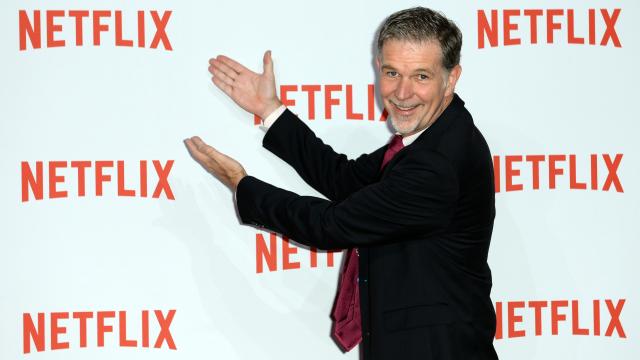Netflix’s stock price fell so fast last month it made the Wile E. Coyote whistle sound effect of a bomb plummeting to earth.
The company blamed its subscribers — the password sharers and exiled Russians, specifically — as a big reason for the drop. Analysts and company critics who spoke to Gizmodo told a different story, though, one of how a company that accrued large amounts of debt to finance its dominance could no longer support itself when subscriber numbers at last began to ebb.
The most popular streaming service in the world reported on its April 19 Q1 earnings call that it had lost 200,000 subscribers where it originally expected to gain 2.5 million. It forecast doom and gloom for next quarter as well, with a predicted loss of two million more.
The company has started laying off employees and shutting down long-anticipated productions in order to stave off further decline. In the Q1 earnings call, co-CEO Reed Hastings laid the issue partially at the feet of consumers. Alongside competition from the likes of Hulu, Apple, and Amazon, he said the company’s biggest issues were:
- 100 million subscribers who share passwords with friends and family, with 30 million of those based in the U.S. and Canada. This is out of a total 222 million global paid memberships.
- The ongoing war in Ukraine, which cost Netflix 700,000 subscribers after it suspended service in Russia.
While there’s no expectation among analysts that Netflix will go the way of the dodo or Blockbuster any time soon, some who have long been sceptical of Netflix are calling bull on how Netflix described its financial woes. Other tech companies have also struggled the first quarter of this year according to their earning statements for a number of reasons, from the war in Ukraine to supply chain issues, but why has Netflix done especially poorly, and why now?
The idea that password sharing is crippling the company is “just the dumbest idea whatsoever,” said Wedbush Securities’ Michael Pachter, a media analyst who has long been critical of the company’s business model. “Incidents of password sharing didn’t grow materially during the quarter. They’ve always known about it.”
Netflix spoke from both sides of its mouth during the April 19 announcement, Pachter said. The company acknowledged in its letter to investors that “account sharing as a percentage of our paying membership hasn’t changed much over the years.” The company claimed the issue with account sharing is that it becomes harder to grow users, but the analyst pointed out that Netflix itself once promoted account sharing in a 2017 tweet.
“There’s no excuse,” Pachter said. “[Hastings] walked in and said, ‘Oh my God, this was because of password sharing,’ and everybody said, ‘Yes, sir. Yes, you’re right.’” Pachter questioned the logic that anybody who isn’t paying for Netflix will suddenly drop money on a subscription if they’re restricted from using another’s account, saying the company is deluded to think that people are so addicted to Netflix content that if they don’t have free access they would immediately subscribe.
Love is sharing a password.
— Netflix (@netflix) March 10, 2017
It had all been going so well, at least according to previous quarter earnings. Hastings said in the Q1 call that, coming out of 2021, company growth “was the logical conclusion. But now, coming into 2022, that doesn’t really hold.” The way forward, he said, was to restrict or monetise account sharing, perhaps add ads, and step up the quality of their content.
Netflix did not respond to a request for comment on its decision regarding account sharing. In its April 19 letter, Netflix said that growth during the early days of the covid pandemic obscured the underlying issues with account sharing and how it was exacerbated by competition and data costs. The company wrote in its the letter that sharing “likely helped fuel our growth by getting more people using and enjoying Netflix,” and that the company facilitated this with features like profiles.

The pandemic-based boom hid the weakness in subscribers until it was too late, said Laura Martin, a senior analyst for Needham. She found the losses in subscribers truly unexpected.
“Their interpretation worked, until it didn’t,” Martin said.
Some other analysts believe that Netflix could simply be hitting a wall in the total number of subscribers that are willing to consume its content, but Netflix CFO Spence Neumann himself described the number of people dropping subscriptions dropping over the last quarter, otherwise known as “churn,” as elevated during Q1. Some estimates of churn among all streaming networks are as high as 37% for U.S. consumers, which has remained consistent over the past two years and is not unique to this past quarter, according to a report by consulting firm Deloitte. Some of those departing subscribers drop their accounts only to pick them up later in the year, but Netflix has stopped publicly releasing its specific churn data in its quarterly earnings reports, meaning it’s hard to tell from the outside just how much of Netflix’s content is actually connecting with viewers.
How did Netflix fall so far?
Sara Silver is a journalism professor at both Quinnipiac University and Columbia University, having spent years working as a reporter on media finances. She regularly teaches classes looking at Netflix’s finances for students and journalists. The way she sees it, Netflix’s issues were apparent for years, even in last year’s earnings when the company was expecting another year of massive growth.
“The story that they told was that all of this would make sense when the denominator got bigger,” Silver said. “They always said that ‘this is going to make sense in the future. We’ll be cash positive in the future. And when we aren’t, we’re going to have way more subscribers and lots more income.’”
In 2015, Netflix was facing a new wave of competition. To fight back, the company borrowed a total of $US15 ($21) billion in the ensuing years meant to fund their new original content productions. Netflix wanted to not only cater to the U.S. or western markets, but create products that South Koreans would enjoy, that the Japanese would watch, that people in Nigeria would binge, and so on.
All this spending seemed to be making the company that much more attractive to investors, and the overall trajectory of the stock price from 2015 to 2021 proved it. The pandemic was a boon for Netflix. Productions shut down, meaning much less money spent in the short term, and meanwhile a worldwide population was stuck in lockdown, bored and looking for something to watch. They were flying high at over 200 million paying customers worldwide. The company was finally cash flow positive after nearly a decade, and not only that, the stock price was $US700 ($972) a share, the highest it had ever been.
Some thought its new positive cashflow was a boon to the company, and that the longtime bears on Netflix’s stock were finally exposed as crying wolf.

But Silver saw an issue with an approach the company outlined in its Q4 2021 earnings. The company announced in its Q4 report that it would purchase back its own stock and pay off some of its bonds that were coming due, leaving around $US15.4 billion in gross debt (Page 53).
“You [buy back stock] when you want to boost your stock price, when you think your stock is undervalued; which is hard to say when it’s $US700 a share,” Silver said.
Pachter agreed that Netflix was overconfident in its predictions.
“I think management was absolutely convinced that they were on a path to greatness,” he said. “Management thought they would grow in perpetuity, that every subscriber was going to be profitable.”
A bigger issue remains Netflix’s business model. Most of its shows and movies are freely available to binge, knocking out a huge chunk of content in a weekend, then leaving customers with potentially hundreds of shows that they have no interest in. It means that in order to constantly maintain subscribers, Netflix has to keep producing content that might cater to many different audiences at rate more furious than all its competitors.
Streamers like HBO have people coming back to shows like Game of Thrones every week, keeping the buzz lasting for months as a season airs. And though the “bingeable shows” model had worked for years, when it finally didn’t, executives needed to point the blame elsewhere, Pachter said.
“It was a gambit,” Silver said. “When things are going right, executives are ‘executing.’ They’re like management super executives. And the second that things go wrong, it’s ‘headwinds’ that are the problem, things outside their control.”
The myth of the invulnerable Netflix
Netflix has long been trying to control the narrative about its ascent to streaming stardom. Critics of its business model, even after the company announced it over-reported expected subscriber growth by last January, were often seen as fist-shaking outliers to the larger consensus of Wall Street analysts claiming Netflix’s invulnerability.

The company’s strategy of maintaining billions of dollars in debt and accruing more with stock buybacks seems to be changing. In its 2022 Q1 earnings letter, Netflix said it had paid off $US700 million (about $970 million) of its debt, putting it in the top end of their $US10-15 billion range it wanted to be in. It made far fewer stock buybacks during that quarter as compared to previous ones.
Either way, it will be a hard road ahead for Netflix, especially considering its competition. Needham’s Martin pointed out that other companies like Amazon or Apple “can spend $US20 billion on original content and not blink.” Plus, their subscriber base is tied to physical products like Apple TV and services like Amazon Prime.
She, along with other analysts and folks in the advertising game, is optimistic that including an ad tier will help the flailing company get back on track. Ad-supported subscription tiers were recently introduced to HBO Max and Disney+, and Netflix could be releasing its own version by the end of the year.
Silver said that Netflix and its investors needs to change their outlook, especially around the way they consider the use of the company’s debt.
“People think they can just buy a slice of the market, go on vacation, and not worry about it. It will go up because the market is going up. Netflix proves that not always the case,” she said.
Pachter doesn’t think the company will change much at all despite the stock drop. Its overall mission and top executives remain the same. The analyst suggested that Netflix could use a shakeup in executive leadership if they really want to move past its current trajectory, but Hastings is considered a “visionary,” and the company is in lockstep behind him.
Pachter remains a Netflix subscriber, but after finishing the latest season of Ozark in a single weekend, he’s currently surfing for something else to watch. He also doesn’t plan to stop sharing his account with his wife and kids any time soon.
